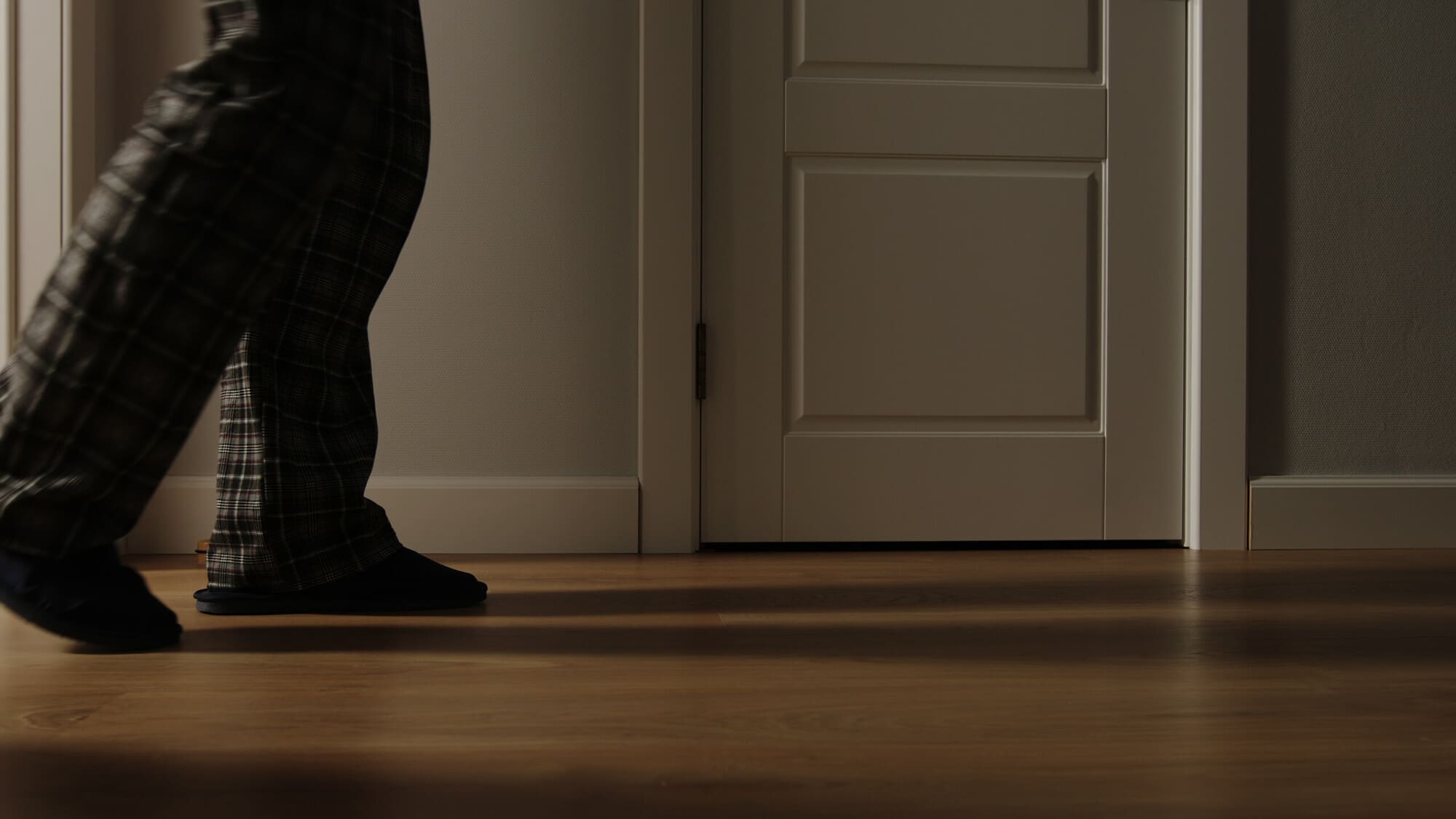In this article
It is estimated that up to 15% of the population sleepwalk. It is more common in children, usually aged between 4 and 8, and it is estimated that 1 in 5 children will sleepwalk at some point. Although sleepwalking in itself is not harmful, it can be dangerous due to the risks of injury to themselves and other people.
What is sleepwalking?
Sleepwalking, also referred to as somnambulism, is a sleep disorder that affects a small percentage of the population.
Sleep is a basic human need and is critical to both physical and mental health. Sleep disorders involve problems with the quality or amount of sleep a person is getting, which can cause problems with normal day-to-day functioning. Sleep-wake disorders can often occur alongside various medical conditions or mental health conditions, including depression, anxiety or cognitive disorders. There are different types of sleep-wake disorders, insomnia being the most common.
Other sleep-wake disorders include:
- Obstructive sleep apnoea.
- Parasomnias.
- Narcolepsy.
- Restless legs syndrome.
Sleep difficulties are usually linked to both physical and emotional problems. Sleep problems can contribute to existing mental health conditions and can also be a symptom of several mental health conditions.
Sleepwalking is one type of sleep disorder. It is where someone walks around or carries out other activities while they are not fully awake. People can experience sleepwalking in different ways. Some people may just sit up in bed and have a look around; this may be brief and they may appear confused. Others may get out of bed and walk around, they may open cupboards, get dressed or even eat. Some sleepwalkers may present as being agitated. In extreme cases, the person may walk outside and carry out complex activities, such as driving a car. In these cases, sleepwalking can be dangerous. Often, the person will have little or no memory of what happened the following day. Sleepwalking is not usually serious, and preventive measures can help in preventing injuries and dangerous situations from occurring.
Sleepwalking usually happens during a period of deep sleep. Deep sleep usually happens during the early part of the night, and so sleepwalking usually happens in the first few hours of sleep.
As you sleep, your brain cycles through four different stages of sleep. The first three stages are considered non-rapid eye movement (NREM) sleep. The fourth stage is rapid eye movement (REM) sleep, also known as active sleep. Each sleep stage has a different function in maintaining your brain’s overall cognitive performance. Sleepwalking is a type of parasomnia which usually happens during periods of deep sleep.
Parasomnia is a category of sleep disorders that involve either abnormal behaviour, movements, emotions, perceptions or dreams that occur while falling asleep, while asleep or during the arousal period in between sleep stages. Examples of other parasomnias include:
- Night terrors.
- Nightmares.
- Rapid eye movement sleep behaviour disorder.
- Sleep-related eating disorder.
- Sleep-related groaning, also known as catathrenia.
Sleepwalking can begin at any age but is more common in children. It’s estimated that 1 in 5 children will sleepwalk at least once. Most children grow out of it but in some cases it can persist into adulthood.

What are the symptoms of sleepwalking?
Sleepwalking does not only involve walking, it can also involve various actions ranging from simple movements to more complex actions. The sleepwalking episode can last anywhere from between a few seconds to half an hour in some cases. The sleepwalking person may wake up feeling confused, or they may return to bed on their own.
A key symptom of sleepwalking and other NREM parasomnias is that the sleepwalking person usually doesn’t have any recollection of the episode when they wake up. A sleepwalking person may be aggressive or even violent in some cases; however, this is uncommon. Studies have found that people who sleepwalk have higher levels of excessive daytime sleepiness and insomnia symptoms. It is unclear whether this is because of disturbances in sleep because of the sleepwalking episode or because of other underlying factors that may be causing sleep problems and the sleepwalking episodes themselves.
Sleepwalking may involve:
- Walking or running.
- Speaking.
- Opening their eyes with a blank look on their face.
- Urinating in inappropriate places.
- Getting dressed or other daily activities.
Another common element of NREM parasomnias is that they usually happen during the first part of the night when a person is in deep NREM sleep stages.
What causes sleepwalking?
Sleep experts believe that sleepwalking usually occurs when a person is in a stage of deep sleep and gets partially awoken in a way that triggers physical activity while remaining asleep. The cause of sleepwalking is not fully understood; however, there are several factors that are thought to contribute. These include:
- Stress and anxiety – stress levels and poor sleep are closely linked as stress often impacts on sleep quality and sleep duration. High levels of stress can lead to abnormal sleep behaviours like sleepwalking.
- Sleep deprivation – lack of sleep can increase the likelihood of sleepwalking as sleep deprivation can disrupt normal sleep cycles and you are likely to spend more time in deep sleep after a period of sleep deprivation.
- A new sleep environment – sleeping in a new, unfamiliar environment can disrupt sleep in some cases which could trigger sleepwalking.
- Certain medication – medication that affects the central nervous system can increase the risk of someone having sleep problems including sleepwalking. Medications with a sedative effect may push people into a type of sleep that increases their chances of having a sleepwalking episode.
- Having a high temperature or other illness – the disruption of normal sleep patterns during illness can contribute to the occurrence of sleepwalking.
- Genetics – having a family history of sleepwalking may make it more likely for someone to experience sleepwalking themselves. Studies show that 47% of children sleepwalk if one parent has a history of it, and 61% of children sleepwalk if both parents do.
- Alcohol or substance use – using alcohol or other substances can affect the central nervous system which can increase the risk of sleepwalking.
- Brain injury – conditions that affect the brain, including swelling of the brain, could trigger sleepwalking episodes. You can access further reading about acquired brain injuries in adults and children by visiting our knowledge base.
- Obstructive sleep apnoea – this is a sleep disorder in which the airway becomes blocked, which causes short lapses in breath during sleep. These create sleep interruptions that make sleepwalking more likely.
- Restless legs syndrome – this is a type of sleep disorder that is characterised by an uncontrollable urge to move the legs, usually accompanied by uncomfortable sensations in the legs. People with restless legs syndrome often experience relief by moving their legs, which can involve activities such as walking, stretching or moving the legs. The symptoms typically worsen during periods of inactivity and can disrupt sleep, leading to difficulties falling asleep or staying asleep. Having the condition makes it more likely that someone would sleepwalk.
Who is affected by sleepwalking?
Sleepwalking can affect people of all ages, although it is more common in children than it is in adults. It occurs more frequently in children between the ages of 4 and 8. It usually stops without the need for any intervention; however, in some cases it can persist into adolescence or adulthood.
There are certain factors that can increase the risk of sleepwalking including:
- Being sleep deprived.
- Being overtired.
- Depression or anxiety.
- Stress.
- A head injury.
- Using alcohol or drugs.
- Being woken up suddenly from a deep sleep.
The impact of sleepwalking
Sleepwalking in itself is not harmful; however, it can be hazardous in certain situations for both the person sleepwalking and potentially other people. Sleepwalking is associated with worse sleep overall and daytime drowsiness.
Some of the dangers associated with sleepwalking include:
- Accidents resulting in injury – this may be due to falls or walking into things. If someone is sleepwalking and they encounter hazards, for example stairs or open windows, they are less likely to exercise the same caution that they do when they are awake.
- Becoming disorientated – this can increase the risk of falls or other accidents occurring.
- Harm to others – if someone who is sleepwalking engages in activities, for example cooking, this could pose a risk to other people due to the risk of a fire occurring. In extreme cases of sleepwalking, the person may actually leave the house and carry out complex activities, such as driving a car, which is extremely dangerous for the person who is sleepwalking and other people on the road.
- Poor judgement and decision-making – as a sleepwalker will usually not fully wake up during their sleepwalking episode, their judgement and decision-making will be impaired. This increases the risk of accidents and injuries.
- If others are not aware of the possibility of sleepwalking occurring, or what to do if it happens, they may react inappropriately, for example startling or restraining the person who is sleepwalking, which may cause them to react violently.
- A person who sleepwalks can also have a negative impact on other members of the household as it can disturb them, it may be unsettling for them, and if the sleepwalking person engages in any dangerous activities while sleepwalking, this could put the other members of the household at risk.
Sleepwalking can also affect how you feel the following day. Lack of sleep or disrupted, poor quality sleep can have a negative effect on your mood and quality of life. Research shows that sleep facilitates a wide range of bodily processes. These include physical changes, such as muscle repair, and mental tasks, such as concentration. The importance of good quality sleep should not be underestimated. Not getting enough or the right kind of sleep can cause a negative mood, low energy, low concentration, and an inability to function as normal. Lack of sleep may have severe consequences in some cases, for example if a person is driving or using heavy machinery when tired.
Sleep helps your brain function properly. Not getting enough sleep or getting poor quality sleep can really affect your quality of life. Sleep problems often coexist with symptoms of depression or anxiety. Sleep problems can exacerbate depression or anxiety, and depression or anxiety can lead to sleep problems. Mind offer some helpful advice about how you can access support for your mental health if this is something you are struggling with.
Lack of sleep and too much sleep are also linked to many chronic health problems, such as heart disease and diabetes. This means that in severe cases of sleepwalking, it can be detrimental to your physical health.
For further reading about the link between sleep and mental health, please see our knowledge base.

Treatment for sleepwalking
If you or your child are sleepwalking occasionally, this does not require medical attention. If sleepwalking is happening frequently, or if you are concerned about the sleepwalking episodes being dangerous, it is recommended that you speak to your GP. The help and support available for sleepwalking depends on the underlying causes and the severity of the condition.
Your GP can refer you to a specialist sleep centre where your or your child’s sleep history can be discussed in more detail. If necessary, sleep studies can be completed in order to exclude other conditions that could be causing the sleepwalking, such as obstructive sleep apnoea, restless legs syndrome or seizures.
Medicine is not usually used to treat sleepwalking; however, in some extreme cases, antidepressants may be used to help you sleep and this may reduce the frequency of sleepwalking.
Therapies such as cognitive behavioural therapy or hypnotherapy may sometimes be helpful. Cognitive behavioural therapy is a talking therapy that can help you manage your problems by changing the way you think and behave. It is most commonly used to treat anxiety and depression, but can be useful for other mental and physical health problems. Hypnotherapy is a psychological therapy that uses hypnosis to treat certain health conditions. Both forms of therapy can help to address thoughts and behaviours or underlying psychological factors that can lead to sleepwalking.
There isn’t any specific treatment for sleepwalking; however, there are some things that you can do to help. These include:
- Regularly get enough, good quality sleep.
- Go to bed at a similar time each night. Lack of sleep or irregular sleep patterns can contribute to sleepwalking.
- Regular exercise.
- Try to relax before going to bed. This may involve meditation, breathing exercises, having a warm bath or reading. Simple routines like these help to signal to your body that it’s time to wind down ready for sleep.
- Try to reduce your stress levels. You can do this by identifying the sources of stress in your life and practising stress-reducing techniques such as mindfulness and meditation, deep breathing exercises, or yoga.
- Make sure your sleep space is dark, quiet and a comfortable temperature.
- Avoid drinking caffeine too close to bedtime.
- Avoid drinking lots of fluid too close to bedtime.
- Remember to go to the toilet before getting into bed.
- Avoid using electronics just before bed including smartphones, tablets, laptops and e-readers as they give off blue light which can suppress the hormone melatonin which can make you feel less sleepy.
- If your child sleepwalks around the same time every night, you could try gently waking them up before this time and then supporting them to go back to sleep. This will disrupt their sleep cycle and may prevent them from sleepwalking altogether.
It is important to consider safety for someone who sleepwalks. This includes things like ensuring a safe sleeping environment in order to prevent injuries during sleepwalking episodes. This may include things like removing obstacles, installing gates on stairs and locking windows and doors to prevent accidental wandering.
If you come across someone who is sleepwalking, it is important to prioritise their safety. This includes:
- Removing any obstacles or hazards in their path in order to prevent accidents from occurring. You should lock any windows and doors in order to prevent the person from wandering outside or getting into dangerous situations.
- It is generally safe to wake a person who is sleepwalking up; however, it is essential to do so gently. Doing this abruptly may startle them, leading to confusion or disorientation.
- Keep your interactions with the person who is sleepwalking to a minimum. This will help to avoid any confrontation as the person may be disorientated.
- If possible, you should gently guide the person who is sleepwalking back to bed. If possible you should do this without waking them up.
Sleepwalking is a sleep disorder, if it occurs regularly or if it becomes dangerous, you should see your healthcare professional.
NHS offer some useful information and advice on where you can access support if you have a sleep problem.






